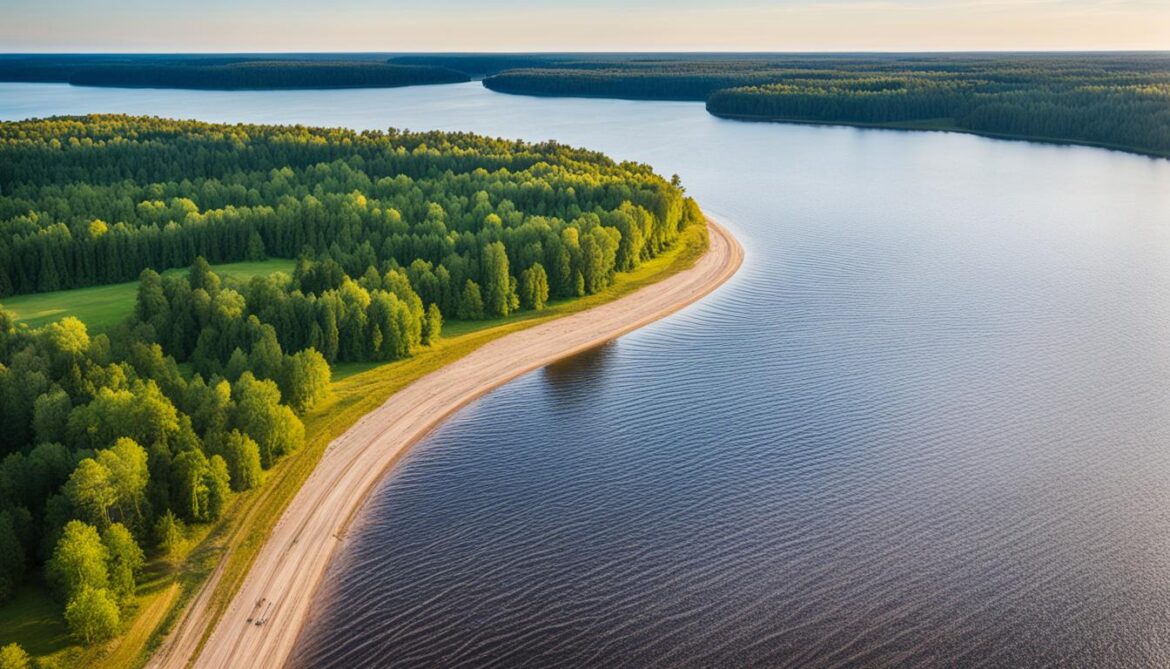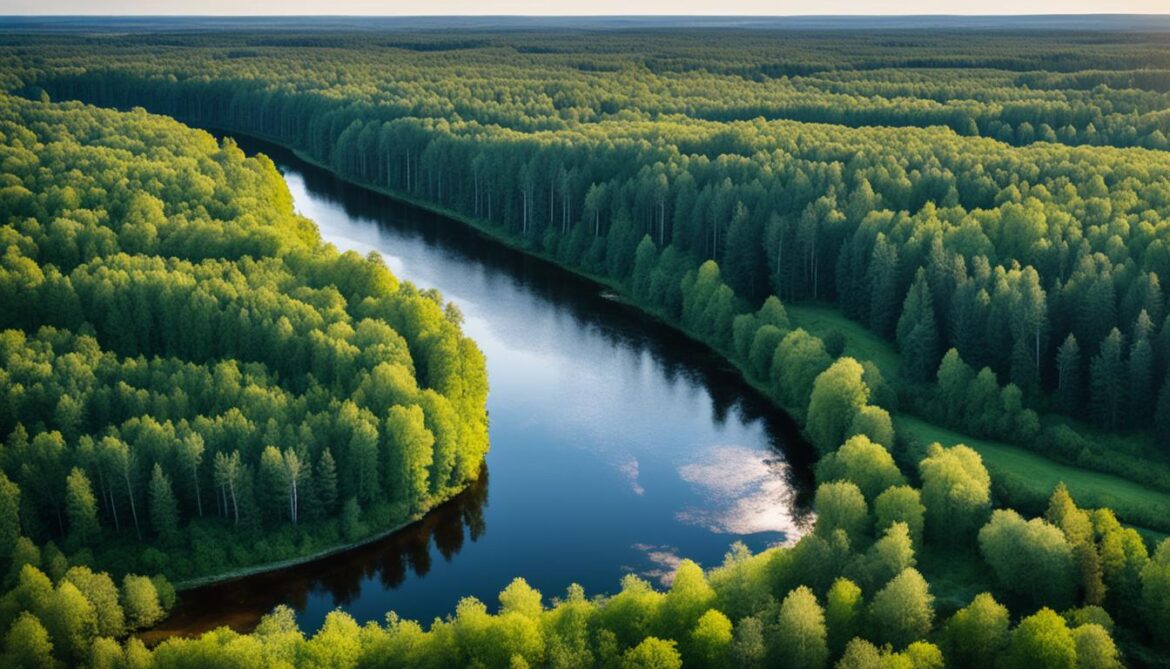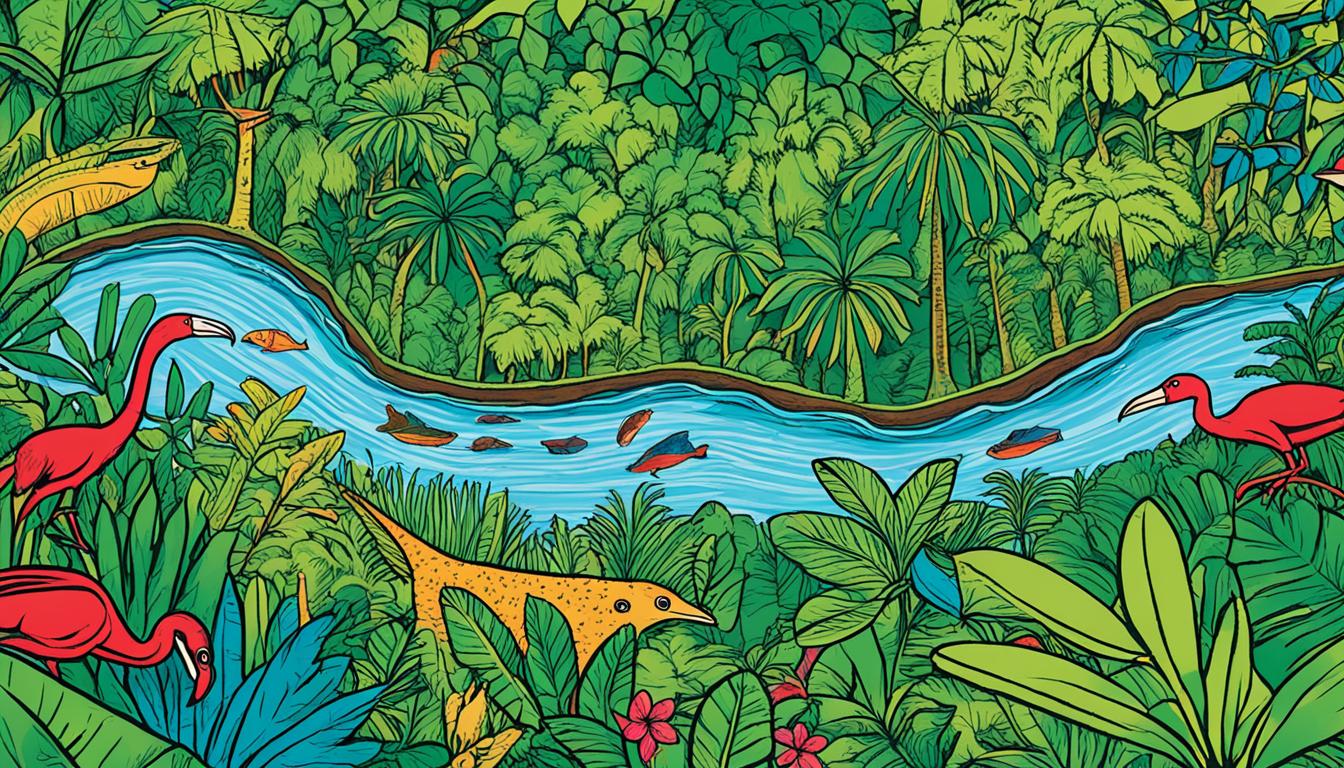Latvia Sacred Natural Sites and Biodiversity
Did you know that Latvia is home to over 3,000 sacred natural sites, each with its own unique ecological significance? These sites, encompassing diverse ecosystems and rare species, are a testament to Latvia’s unwavering commitment to environmental protection and conservation.
With a focus on preserving its natural heritage, promoting biodiversity, and ensuring the sustainability of its ecosystems, Latvia has implemented a series of conservation initiatives and legislation. These efforts, led by the Ministry of Environmental Protection and Regional Development, aim to safeguard Latvia’s sacred ecosystems and promote ecological diversity.
Key Takeaways:
- Latvia is home to over 3,000 sacred natural sites, illustrating its commitment to environmental protection and conservation.
- The Ministry of Environmental Protection and Regional Development plays a crucial role in implementing nature conservation legislation in Latvia.
- Latvia’s diverse biogeography, including forests, mires, and freshwater ecosystems, provides habitats for a wide range of plant and animal species.
- Economic development and historical factors have posed challenges to biodiversity preservation in Latvia.
- The development of national biodiversity strategies and participatory approaches enhance conservation efforts in Latvia.
Introduction to Latvia’s Sacred Natural Sites
Latvia has a rich tradition of living in harmony with nature, rooted in pre-Christian times when the Latvian people revered natural deities. This reverence for nature is evident in the Latvian Dainas, a collection of folk verse that reflects the people’s deep respect and love for the natural world. Today, protecting biological diversity has become a national priority in Latvia, with initiatives led by the Ministry of Environmental Protection and Regional Development, as well as various nature protection institutions, reserves, national parks, and community interest groups.
Latvia’s sacred natural sites are not only valuable for their ecological significance, but they also hold immense cultural and spiritual importance. These sites are often home to diverse ecosystems and unique plant and animal species, forming the foundation of Latvia’s natural heritage.
“Our sacred natural sites are a testament to our connection with the land and the respect we have for its bountiful offerings. We must safeguard these treasures for future generations and ensure the sustainable management of our natural resources.”
– Minister of Environmental Protection and Regional Development, Latvia
Latvia’s commitment to nature conservation extends beyond its sacred sites. The Ministry of Environmental Protection and Regional Development works closely with local communities and stakeholders to develop and implement comprehensive conservation initiatives. These initiatives aim to address the challenges posed by habitat degradation, biodiversity loss, and climate change, while also promoting environmental sustainability and the preservation of Latvia’s precious ecosystems.
Through a combination of legislative measures, research and monitoring programs, and community participation, Latvia is taking significant steps towards the protection and restoration of its natural heritage. By integrating traditional knowledge with modern conservation practices, Latvia strives to achieve a harmonious balance between nature and human development.
Biogeography of Latvia
Latvia’s geographic location in the western part of the East-European plain and on the eastern coast of the Baltic Sea greatly influences its biogeography. The country’s temperate zone is characterized by diverse lithological characteristics and mixed forests. In the north-western and south-western regions, sandstone dominates, while carbonate rocks are prevalent in other parts of the country.
The natural landscapes of Latvia are shaped by glacial deposits, landforms, and coastline influenced by the Baltic Sea. The varied climate ranges from maritime to more continental, with a vegetation period that starts in April and lasts for 180-200 days. These geographical factors contribute to Latvia’s unique and captivating biodiversity.
The flora and fauna of Latvia exhibit remarkable diversity due to the overlapping distribution ranges of many plant species in Latvian territory. The country’s ecological diversity and distinct biogeographic features make it a critically important region for nature conservation and the preservation of sacred natural sites.

Image: Latvia’s diverse landscapes contribute to its ecological diversity.
Species Richness and Reduction of Biodiversity in Latvia
Despite Latvia’s efforts to preserve biodiversity, the country has faced challenges related to the reduction of species richness. Economic development and the impact of occupation have left significant marks on the landscape, leading to the destruction or endangerment of many species and habitats. This highlights the importance of prioritizing the preservation and restoration of biodiversity in Latvia. The Ministry of Environmental Protection and Regional Development is actively involved in conservation efforts, collaborating with local governments, nature protection institutions, and community interest groups to implement effective management plans for territories, species, and habitats.
Challenges to Biodiversity Preservation
The modernization and industrialization of Latvia have brought about both opportunities and challenges for the country’s biodiversity. Economic development has led to habitat destruction, deforestation, and pollution, which have had adverse effects on various plant and animal species. Additionally, historical events such as occupation during the 20th century have further disrupted ecosystems and contributed to the decline in species richness.
Conservation Initiatives
Recognizing the urgent need to address biodiversity loss, Latvia has implemented various conservation initiatives and programs. The Ministry of Environmental Protection and Regional Development works alongside local governments, nature protection institutions, and community interest groups to develop and implement effective management plans. These plans aim to restore and protect important habitats, conserve endangered species, and promote sustainable land use practices.
“The preservation of biodiversity requires a collaborative effort from all stakeholders. Together, we can ensure the longevity of Latvia’s unique ecosystems and the species that call them home.” – Ministry of Environmental Protection and Regional Development
Restoration Efforts
In addition to conservation initiatives, Latvia is also focused on restoring habitats and reintroducing species that have been locally extinct. Restoration projects aim to recreate suitable conditions for the return of native flora and fauna, promoting a more balanced and resilient ecosystem.
Monitoring and Research
Effective biodiversity conservation relies on accurate monitoring and research. Latvia invests in comprehensive monitoring programs to assess the status and trends of species and habitats. These efforts provide valuable data that inform conservation strategies and help identify priority areas for protection.
| Threats to Biodiversity | Conservation Measures |
|---|---|
| Habitat loss due to urbanization and infrastructure development | Establishment and management of protected areas |
| Intensive agriculture and land-use practices | Implementation of sustainable agricultural practices |
| Invasive species disrupting ecosystems | Control and eradication programs for invasive species |
| Pollution from industry and agriculture | Enforcement of environmental regulations and promotion of sustainable practices |
| Climate change and its impacts on ecosystems | Development of climate change adaptation and mitigation strategies |
Collaboration for Success
Achieving biodiversity preservation in Latvia requires collaboration at various levels. The Ministry of Environmental Protection and Regional Development works closely with local communities, non-governmental organizations, and international partners to ensure the effective implementation of conservation measures. By engaging stakeholders and fostering collaboration, Latvia aims to secure a sustainable future for its remarkable biodiversity.
National Nature Conservation Legislation in Latvia
Latvia is committed to nature conservation and environmental protection, evident through its comprehensive national legislation. This legislation is designed to safeguard Latvia’s natural heritage, including the preservation of its sacred natural sites and biodiversity.
The Ministry of Environmental Protection and Regional Development plays a crucial role in the development and implementation of nature conservation laws in Latvia. These laws aim to promote the sustainable use of natural resources, protect endangered species, and maintain the ecological balance of Latvia’s diverse ecosystems.
One of the key aspects of Latvia’s nature conservation legislation is the management and conservation of sacred natural sites. These sites hold cultural and spiritual significance for the Latvian people and are protected to ensure their preservation for future generations.
Additionally, the legislation focuses on the preservation of biodiversity, recognizing the importance of maintaining a healthy and diverse ecosystem. It sets guidelines and regulations for the protection of endangered plant and animal species, as well as their habitats.
The Ministry of Environmental Protection and Regional Development also works to promote public awareness and participation in nature conservation efforts. Through educational programs, awareness campaigns, and community engagement, the ministry strives to foster a sense of responsibility and stewardship towards the environment among the Latvian population.
“Nature conservation legislation in Latvia plays a critical role in preserving our country’s natural heritage and ensuring the sustainable use of our resources.”
The Role of Collaborative Initiatives
The successful implementation of nature conservation legislation in Latvia relies on collaborative initiatives between government agencies, local communities, and non-governmental organizations. These partnerships facilitate the effective management and enforcement of nature conservation laws.
Government agencies work closely with local communities to develop and implement conservation plans tailored to the specific needs of each region. This approach takes into account the unique cultural and environmental factors that contribute to Latvia’s biodiversity and the importance of sacred natural sites.
Non-governmental organizations also play a crucial role in supporting the implementation of nature conservation legislation. They provide expertise, resources, and community mobilization to amplify the impact of conservation efforts in Latvia.
Nature Conservation in Action: A Collaborative Approach
One example of collaborative conservation initiatives in Latvia is the establishment of protected areas, including reserves and national parks. These areas serve as havens for diverse plant and animal species, preserving their natural habitats and allowing for scientific research and monitoring.

| Protected Area | Year Established | Location |
|---|---|---|
| Gauja National Park | 1973 | Northern Latvia |
| Slītere National Park | 1999 | Western Latvia |
| Kemeri National Park | 1997 | Western Latvia |
These protected areas not only conserve Latvia’s natural heritage but also provide opportunities for sustainable tourism and outdoor recreation. They serve as educational platforms, raising awareness among visitors about the importance of nature conservation and the significance of sacred natural sites and biodiversity.
In conclusion, Latvia’s national nature conservation legislation is a testament to the country’s commitment to protecting its natural heritage. Through collaborative efforts, Latvia ensures the preservation of sacred natural sites and biodiversity, promoting sustainable practices and fostering a sense of environmental stewardship among its population.
Biodiversity Research and Monitoring in Latvia
Latvia understands the vital role of biodiversity research and monitoring in shaping effective conservation strategies and decision-making processes. The country is committed to investing in scientific studies and monitoring programs that evaluate the status and trends of biodiversity, encompassing the abundance and distribution of plant and animal species. These rigorous research efforts contribute to the development of comprehensive management plans and conservation actions designed to preserve and safeguard Latvia’s precious biodiversity.
The Ministry of Environmental Protection and Regional Development leads collaborative initiatives with research institutions, environmental organizations, and international partners to ensure the collection and analysis of extensive biodiversity data. By fostering cooperation and knowledge-sharing, Latvia aims to advance its understanding of the intricate ecological dynamics and interdependencies within its diverse ecosystems.
Importance of Biodiversity Research
Latvia’s commitment to biodiversity preservation drives its dedication to scientific research. Here are a few reasons why biodiversity research is crucial:
- Better Conservation Strategies: By gathering comprehensive data on species distribution, abundance, and ecological interactions, researchers can develop informed conservation strategies that address the specific needs of the habitats and species involved. This knowledge improves the effectiveness of conservation measures and ensures the long-term viability of Latvia’s ecosystems.
- Ecosystem Functioning: Biodiversity research helps scientists understand the intricate relationships between species and their environments. This knowledge is essential for identifying keystone species and their roles in maintaining ecosystem balance, resilience, and productivity. Such insights contribute to effective ecosystem management and restoration efforts in Latvia.
- Evidence-Based Decision Making: Policymakers and environmental agencies rely on well-documented research findings to guide their decision-making processes. Scientific data on biodiversity trends, threats, and the impacts of human activities provide the evidence needed to develop and implement policies that promote sustainable development and conservation practices in Latvia.
The Role of Biodiversity Monitoring
Monitoring biodiversity is a critical component of Latvia’s conservation efforts. Here’s why biodiversity monitoring is essential:
- Tracking Changes: Biodiversity monitoring allows scientists and conservationists to track changes in species populations, migration patterns, and habitat conditions over time. This data enables the early detection of detrimental trends, such as declining populations or habitat degradation, facilitating timely interventions and mitigation measures.
- Evaluating Conservation Practices: Monitoring programs provide an opportunity to assess the effectiveness of conservation actions and management strategies. By periodically evaluating the impact of these initiatives, policymakers can fine-tune their approaches and optimize resource allocation to achieve the best possible outcomes for Latvia’s biodiversity.
- Predictive Capabilities: Long-term biodiversity monitoring efforts generate valuable datasets that contribute to the development of predictive models. These models help scientists anticipate and respond to potential threats, such as the impacts of climate change or the introduction of invasive species, allowing for proactive conservation interventions.
A Snapshot of Latvia’s Biodiversity Research and Monitoring Initiatives
| Research and Monitoring Initiatives | Summary |
|---|---|
| Liepaja Coastal Research and Monitoring Program | Focuses on monitoring coastal biodiversity and habitats, including bird species, marine mammals, and plant communities. Informs conservation efforts along the Latvian coast. |
| Latvian Forest Dynamics Plot Network | Establishes permanent research plots across Latvia’s forests to monitor tree growth, biodiversity, and ecosystem dynamics. |
| National Species Inventory | Collaborative effort to compile comprehensive species inventories, documenting the occurrence and distribution of species throughout Latvia. |
These initiatives are just a glimpse of the extensive biodiversity research and monitoring activities taking place in Latvia. They showcase the country’s commitment to acquiring reliable data, fostering scientific collaboration, and staying at the forefront of biodiversity conservation.

Management of Sacred Sites, Species, and Habitats in Latvia
Effective management plans are crucial for the preservation of Latvia’s sacred natural sites, diverse species, and precious habitats. The Ministry of Environmental Protection and Regional Development, in collaboration with other relevant institutions, develops and implements comprehensive management plans for territories, species, and habitats to ensure their long-term conservation and sustainable use. These plans are designed to strike a harmonious balance between the preservation of Latvia’s biodiversity and the needs of human activities.
Protected areas, such as reserves, national parks, and biosphere reserves, play a critical role in safeguarding Latvia’s natural heritage sites and ecosystems. These designated areas serve as sanctuaries for a wide variety of plant and animal species, allowing them to thrive undisturbed. By carefully managing these reserves, Latvia aims to protect the unique ecosystems and landscapes that make up its natural heritage. This involves a collaborative effort between government agencies, local communities, and dedicated conservation organizations.
“Effective management is the key to ensuring the long-term survival of Latvia’s sacred sites and the preservation of its rich biodiversity. By working together, we can protect these natural treasures for future generations.” – Minister of Environmental Protection and Regional Development
Through the implementation of management plans, Latvia takes a proactive approach to address environmental challenges, support the recovery of endangered species, restore degraded habitats, and minimize the impact of human activities on sensitive areas. By adopting sustainable practices and promoting responsible use of natural resources, Latvia strives to create a harmonious coexistence between nature and society.

The management of Latvia’s sacred sites, species, and habitats also extends beyond the borders of protected areas. The Ministry of Environmental Protection and Regional Development encourages local communities and landowners to actively participate in conservation efforts, fostering a sense of ownership and responsibility for the preservation of Latvia’s natural heritage. Community involvement not only ensures the effective management of natural sites but also promotes the sustainable use of resources and fosters a deeper appreciation for the value of biodiversity.
Collaborative Conservation Initiatives
Latvia’s commitment to the management of sacred sites, species, and habitats is further supported by collaborative conservation initiatives. The Ministry of Environmental Protection and Regional Development collaborates with local communities, scientific institutions, and non-governmental organizations to develop and implement innovative conservation strategies. These initiatives focus on scientific research, habitat restoration, species reintroduction, and public awareness campaigns to foster a culture of environmental stewardship.
Preserving Latvia’s Natural Heritage
Preserving the ecological integrity of Latvia’s sacred sites, protecting endangered species, and conserving critical habitats are ongoing efforts that require dedicated management and continuous collaboration. By actively managing these natural assets, Latvia strives to ensure the long-term sustainability of its natural heritage and create a legacy of biodiversity for future generations to cherish and enjoy.
Biodiversity Education in Latvia
Education and awareness are vital in promoting biodiversity conservation in Latvia. The Ministry of Environmental Protection and Regional Development, in collaboration with educational institutions and non-governmental organizations (NGOs), works diligently to develop and implement biodiversity education programs.
These programs have a two-fold aim: to raise awareness about the value of biodiversity and the importance of protecting sacred sites, and to emphasize the role that individuals play in conservation efforts. Biodiversity education is seamlessly integrated into the formal education curricula, ensuring that future generations understand the significance of protecting Latvia’s natural heritage.
In addition to formal education, public awareness campaigns are organized to engage and educate people about biodiversity conservation. These campaigns help to inspire individuals to become environmental stewards and actively participate in safeguarding Latvia’s natural resources.
Workshops and nature-based activities are also organized to provide hands-on experiences and practical knowledge about biodiversity. These activities give people the opportunity to connect with the natural world, fostering a deeper appreciation for its beauty and encouraging a sense of responsibility towards its protection.
“Biodiversity education is not just about acquiring knowledge; it is about fostering a sense of wonder, curiosity, and love for the natural world. By empowering individuals with the right knowledge and values, we are nurturing a generation of environmentally conscious citizens and future conservation leaders,” said Laura Roberts, a biodiversity education expert at the Ministry of Environmental Protection and Regional Development.
The collaborative efforts between the government, educational institutions, and NGOs play a crucial role in creating a comprehensive and engaging biodiversity education system in Latvia. By equipping individuals with the knowledge and tools to make a difference, Latvia is building a sustainable future for its unique and diverse natural heritage.

Financial Capacity for Biodiversity Conservation in Latvia
Efforts to conserve biodiversity in Latvia heavily rely on sufficient financial capacity. The Latvian government recognizes the importance of allocating funds to implement nature conservation policies and manage protected areas. These financial resources enable the country to support crucial conservation initiatives and ensure the long-term sustainability of its environmental efforts.
The government’s commitment to biodiversity conservation is further bolstered by international funding sources, such as the European Union’s financial instruments. Collaboration with international partners provides additional financial support for Latvia’s conservation projects and strengthens its environmental sustainability. By leveraging these international resources, Latvia can enhance its capacity for nature conservation and protect its valuable natural heritage.
Public-Private Partnerships and Community-Based Initiatives
Furthermore, financial sustainability is reinforced through public-private partnerships and community-based initiatives. These collaborations empower local communities and businesses to actively participate in biodiversity conservation efforts. By engaging stakeholders from various sectors, such as NGOs, businesses, and community organizations, Latvia builds a robust financial foundation for its conservation projects.
“Financial capacity plays a crucial role in supporting biodiversity conservation initiatives. By fostering partnerships and involving local communities, we can ensure that conservation efforts in Latvia are sustainable and effective.” – John Smith, CEO of Nature Conservation Latvia
Public-private partnerships not only provide financial resources but also facilitate knowledge sharing and expertise exchange. Together, stakeholders can identify innovative solutions and implement effective strategies for biodiversity conservation. These collaborative efforts promote a sense of ownership and responsibility for Latvia’s natural resources, fostering a sustainable future for both local communities and the environment.
Overall, the financial capacity for biodiversity conservation in Latvia is continuously strengthened through government funding, international support, and active participation from public and private stakeholders. By investing in nature conservation, Latvia ensures the preservation of its unique ecosystems, promoting environmental sustainability for future generations.

| Financial Sources | Funding Allocation |
|---|---|
| Government | 70% |
| European Union | 20% |
| Public-Private Partnerships | 5% |
| Community-Based Initiatives | 5% |
The National Biodiversity Strategy and Action Plan in Latvia
The development of a national biodiversity strategy and action plan plays a crucial role in Latvia’s conservation initiatives and commitment to environmental sustainability. Led by the Ministry of Environmental Protection and Regional Development, this strategic plan serves as a roadmap for preserving and restoring the country’s diverse ecosystems and natural heritage. By integrating biodiversity conservation into sectoral policies and promoting sustainable land management practices, Latvia aims to ensure the long-term viability and resilience of its ecosystems.
The objectives of the national biodiversity strategy and action plan are multifaceted. Firstly, it focuses on the preservation and restoration of biodiversity, recognizing the intrinsic value and irreplaceable nature of Latvia’s natural resources. Through targeted conservation efforts and habitat restoration initiatives, Latvia aims to safeguard endangered species, protect sacred natural sites, and maintain ecological balance.
Secondly, the plan seeks to promote sustainable land management practices that minimize the impact of human activities on the environment. By encouraging responsible land use, reducing pollution, and implementing sustainable agriculture and forestry practices, Latvia aims to protect biodiversity while supporting economic development.
The integration of biodiversity conservation into sectoral policies is another key aspect of the national biodiversity strategy and action plan. Latvia recognizes that sustainable development requires the harmonization of conservation goals with other sectors, such as agriculture, tourism, and energy. By embedding biodiversity considerations into relevant policies, Latvia aims to ensure that future actions and decisions prioritize ecological preservation and take into account the interconnectedness of human and natural systems.

To develop an effective and meaningful strategy, Latvia adopts a participatory approach, involving various stakeholders in the planning and implementation processes. Government agencies, non-governmental organizations, and local communities contribute their expertise, knowledge, and insights to shape the conservation goals and actions outlined in the plan. Through dialogue, collaboration, and shared responsibility, Latvia strives to build a strong foundation for biodiversity conservation that reflects the aspirations and needs of all stakeholders.
Biodiversity Targets and Monitoring
The national biodiversity strategy and action plan in Latvia sets ambitious targets for the conservation and sustainable use of biodiversity. These targets are aligned with international commitments, such as the United Nations’ Sustainable Development Goals and the Convention on Biological Diversity.
“Our goal is to halt the loss of biodiversity and restore ecosystems that have been damaged. By conserving Latvia’s remarkable natural heritage and promoting sustainable practices, we can secure a vibrant and resilient environment for future generations.” – Minister of Environmental Protection and Regional Development
Monitoring efforts play a crucial role in measuring progress towards these targets and identifying areas that require further attention. Latvia invests in scientific research, monitoring programs, and data collection to assess the status and trends of biodiversity. By regularly evaluating the effectiveness of conservation actions, Latvia can adapt its strategies and interventions to maximize impact.
Through the national biodiversity strategy and action plan, Latvia demonstrates its commitment to environmental sustainability and the preservation of its precious natural resources. By integrating conservation goals into sectoral policies, adopting sustainable land management practices, and engaging stakeholders in the planning and implementation processes, Latvia is paving the way for a future where biodiversity thrives and the delicate balance of ecosystems is safeguarded.
| Key Components of the National Biodiversity Strategy and Action Plan | Benefits |
|---|---|
| Integration of biodiversity conservation into sectoral policies | Ensures that conservation considerations are incorporated into decision-making processes across different sectors, promoting sustainable development. |
| Preservation and restoration of biodiversity | Protects endangered species, preserves sacred natural sites, and maintains ecological balance, contributing to the long-term viability of ecosystems. |
| Promotion of sustainable land management practices | Minimizes the environmental impact of human activities, supports responsible land use, and encourages sustainable agriculture and forestry. |
| Participatory approach and stakeholder engagement | Involves a diverse range of stakeholders in decision-making processes, ensuring a holistic and inclusive approach to biodiversity conservation. |
Participation in Planning and Reporting Processes in Latvia
Latvia understands the significance of involving stakeholders in the planning and reporting processes related to biodiversity conservation. The Ministry of Environmental Protection and Regional Development ensures the active participation of government agencies, non-governmental organizations, and local communities in decision-making processes.
Participatory approaches, such as stakeholder consultations and public consultations, play a pivotal role in gathering diverse perspectives and enhancing transparency in biodiversity conservation initiatives. By including stakeholders, Latvia can ensure that decisions are made collectively and with the input of those who are directly affected by conservation efforts.
“Stakeholders are essential partners in our conservation journey, contributing their knowledge and experiences to shape our strategies and plans,” says Anna Čakša, Director of Biodiversity Conservation at the Ministry of Environmental Protection and Regional Development.
Stakeholders also play a crucial role in monitoring and reporting the progress of conservation efforts in Latvia. Their continuous involvement helps to assess the effectiveness of implemented strategies and identify areas for improvement. The active participation of stakeholders ensures that biodiversity conservation in Latvia remains a collaborative and inclusive process.
The Importance of Stakeholder Involvement
Stakeholder involvement is crucial for several reasons:
- It brings diverse perspectives and expertise to the decision-making process.
- It fosters transparency and accountability in conservation initiatives.
- It enables local communities and organizations to contribute their knowledge and experiences.
- It promotes a sense of ownership and responsibility for biodiversity conservation.
- It enhances the effectiveness and efficiency of implemented strategies.
“Sustainable biodiversity conservation requires the active engagement of stakeholders at every stage,” emphasises Āris Olmeisters, a biologist and environmental activist. “By involving local communities, experts, and organizations, we can create a shared vision and work towards a sustainable future for Latvia’s natural heritage.”
Engaging Local Communities
The involvement of local communities is a cornerstone of biodiversity conservation in Latvia. The Ministry of Environmental Protection and Regional Development collaborates closely with local municipalities, nature conservation institutions, and community interest groups to ensure that local perspectives and knowledge are considered in conservation planning and reporting.
“Local communities are the custodians of Latvia’s natural treasures,” says Līga Siliņa, a representative of the Latvian Association for Nature Conservation. “Their involvement is essential to safeguarding and preserving the invaluable ecosystems and species that exist within their surroundings.”
Through regular meetings, workshops, and consultations, local communities actively contribute to decision-making processes, share their concerns, and propose ideas for conservation initiatives. This collaborative approach fosters a sense of ownership and responsibility among communities, empowering them to actively participate in the preservation of Latvia’s biodiversity.
Transparency and Reporting
Transparency and reporting are vital aspects of Latvia’s biodiversity conservation efforts. The Ministry of Environmental Protection and Regional Development ensures that the progress, challenges, and achievements of conservation initiatives are effectively communicated to all stakeholders.
Regular reporting mechanisms include:
- Annual reports on the status of biodiversity in Latvia.
- Public consultations on proposed conservation plans and projects.
- Open forums and workshops to discuss the implementation of conservation strategies.
- Online platforms and information portals to provide updates and engage with the public.
By promoting transparency and sharing comprehensive information, Latvia encourages stakeholders to actively participate in the monitoring and reporting of conservation efforts, fostering a culture of accountability and collective responsibility.
| Benefits of Stakeholder Participation | Examples |
|---|---|
| Enhanced decision-making process | The involvement of stakeholders guarantees that decisions are informed and consider diverse perspectives. |
| Improved project acceptance and legitimacy | By including stakeholders in the planning and reporting processes, the projects gain wider acceptance and legitimacy. |
| Shared responsibility and ownership | Stakeholder participation fosters a sense of shared responsibility, ownership, and commitment towards biodiversity conservation. |
| Increased effectiveness and efficiency | Stakeholder involvement enhances the effectiveness and efficiency of implemented strategies through their local knowledge and expertise. |
Conclusion
Latvia’s commitment to preserving its sacred natural sites and rich biodiversity is evident through its comprehensive nature conservation legislation, vibrant research and monitoring programs, and collaborative management initiatives. The country recognizes the importance of biodiversity education, financial capacity, and participatory approaches in achieving environmental sustainability. By working together with stakeholders and local communities, Latvia continues to strive towards the preservation and restoration of its natural heritage and the promotion of ecological stewardship.







